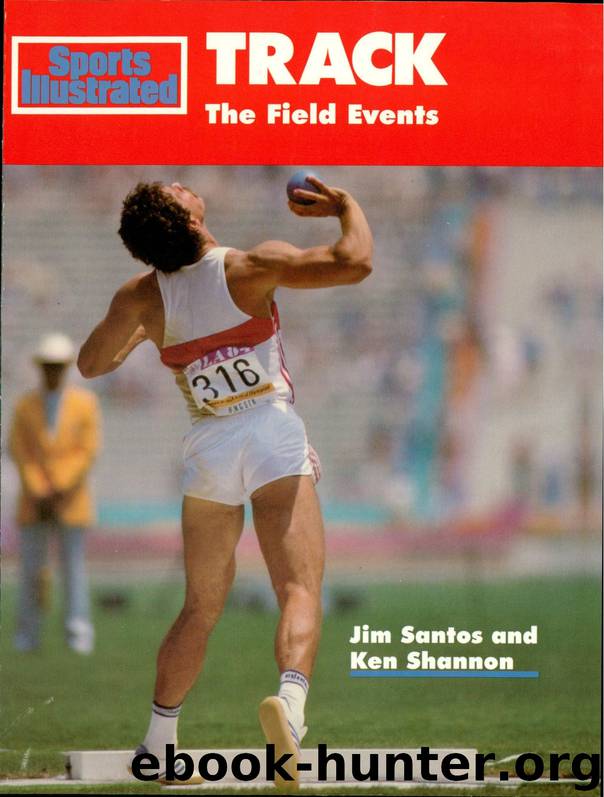Track: The Field Events by Santos Jim Shannon Ken & Ken Shannon

Author:Santos, Jim,Shannon, Ken & Ken Shannon [Santos, Jim]
Language: eng
Format: epub
ISBN: 9781461712503
Publisher: Sports Illustrated
Published: 2013-09-08T16:00:00+00:00
THE LONG JUMPER AND TRIPLE JUMPER
Knowing that you have three preliminary jumps, and if you are successful, three more jumps in the finals, means that your attitude is different from a vertical jumper’s. As a horizontal jumper, you must jump against yourself for improvement and against the other jumpers in order to win.
How do you react when an opponent gets off a great jump on her first attempt? Do you look forward to the challenge, or do you find yourself settling for second or third place? Do you fall apart trying to outdo all your opponents? Or do you settle yourself down and generate a positive attitude so that you can get off a good technical jump?
If this is your last attempt and you have to improve by only 1 inch in order to win the event, do you go all out or do you play it somewhat safe, extending yourself only enough to get that last necessary inch? There are many ways that jumpers can respond to competition; the challenge for you is to bring out your best no matter what the circumstances.
Let’s look at your first attempt as a horizontal jumper. Whether it’s the long or the triple jump, the situation you face on the first attempt is the same. First of all, compete only against yourself on the first jump. Go for a big jump on your first attempt. Hold nothing back. If your first jump is mediocre, your opponents will be gleeful, knowing that on their first attempts they can bury you. Don’t give them that satisfaction. Go for it on your first jump. Go for it on your second jump. And if you are still not doing well, or are simply holding your own in the competition, continue to go for every jump that you have coming to you. In 1984 Carl Lewis won the Olympic gold medal in the long jump on his second attempt. In 1968 Bob Beamon won the Olympic gold medal and set a world record (29 feet 2 inches) in the long jump on his first attempt. What does that tell you? The best long jumpers in the world go for it on their first attempts!
For any horizontal jump, if you approach the takeoff board with anything less than your normal jumping speed, you’ll find you’ll be taking off behind the board. If you approach the board at full speed but then settle into a conservative last four strides (slowing down a bit), you will be over the takeoff board and will foul the jump. Do you practice slow approaches? I think not.
If you are a triple jumper, you have to maintain a strong positive attitude toward all three phases—Hop, Step, and Jump. Do not let yourself break down just because you don’t feel right once you hop, as this could lead to an injury. Remain strong, so that your legs and body position are ready for the landing and the Step phase. If your Hop is really bad, bail out; don’t risk an injury.
Download
This site does not store any files on its server. We only index and link to content provided by other sites. Please contact the content providers to delete copyright contents if any and email us, we'll remove relevant links or contents immediately.
Father Water, Mother Woods by Gary Paulsen(1248)
Greyson Gray by B.C. Tweedt(1189)
Raw Blue by Kirsty Eagar(1183)
Breakaway by Alex Morgan(1150)
Reds by Ted Morgan(1130)
Ultimate Sports by Donald R. Gallo(1112)
Right on Track by Sanya Richards-Ross(1102)
No Summit out of Sight by Jordan Romero(1090)
My Shot by Elena Delle Donne(1089)
Unsinkable by Jessica Long(1074)
Gary Paulsen by Caught by the Sea(1070)
The Dangerous Book for Boys by Conn Iggulden(1043)
Caught by the Sea by Paulsen Gary(1014)
Samurai Rising by Pamela S. Turner(1012)
Babe Ruth by Tracy Brown Collins(1008)
Grace, Gold, and Glory: My Leap of Faith by Gabrielle Douglas & Michelle Burford(993)
Shohei Ohtani by Jay Paris(991)
Stotan! by Chris Crutcher(974)
For the Love of Horses: The Wilson Sisters' Inspiring Journey to Save New Zealand's Wild Horses by Wilson Kelly(946)
